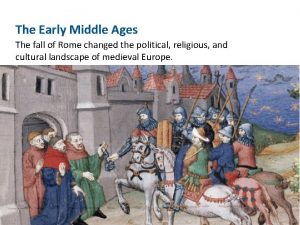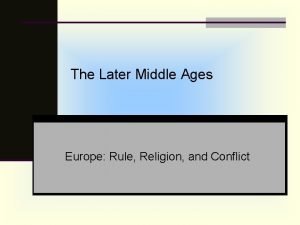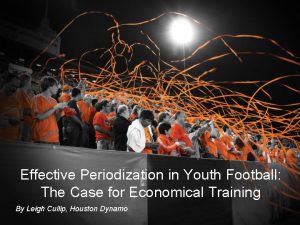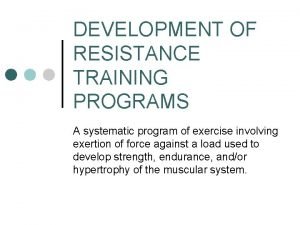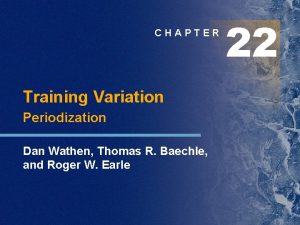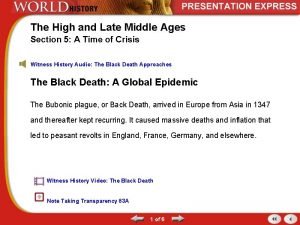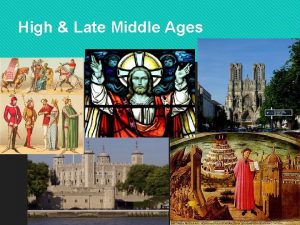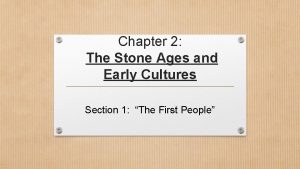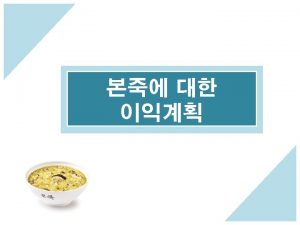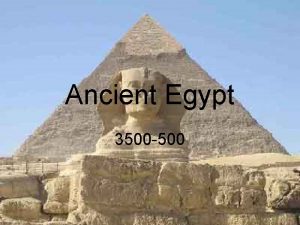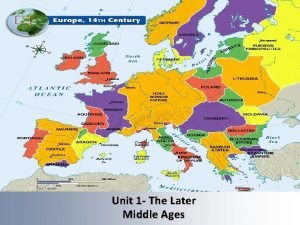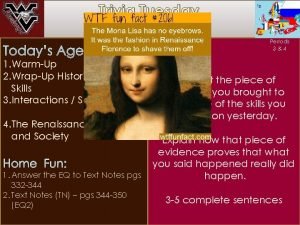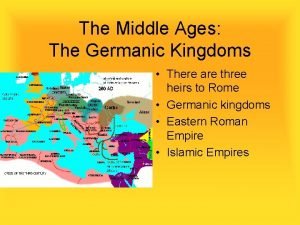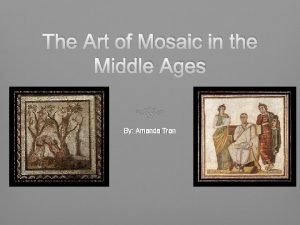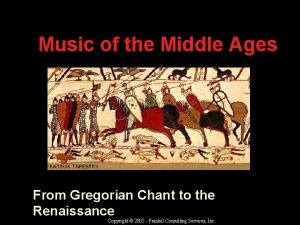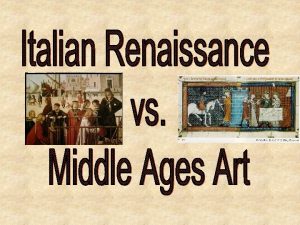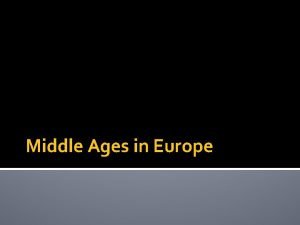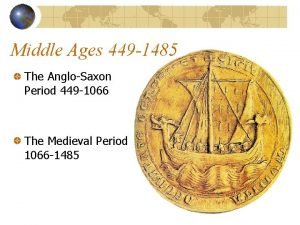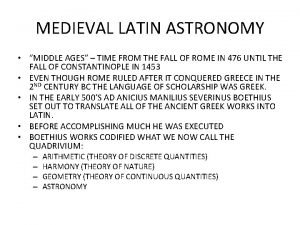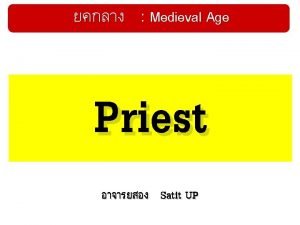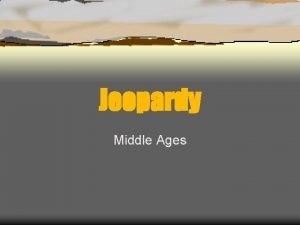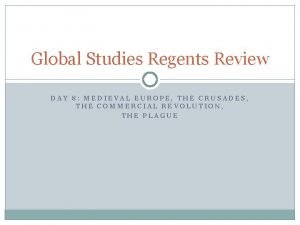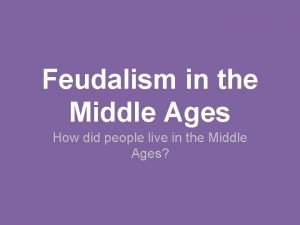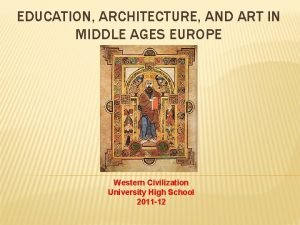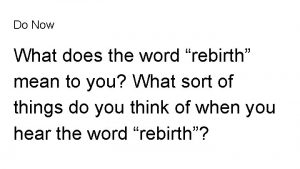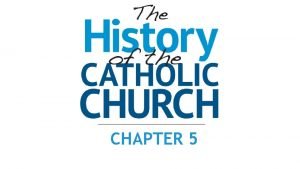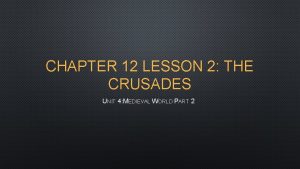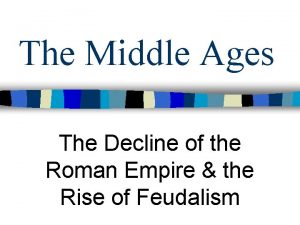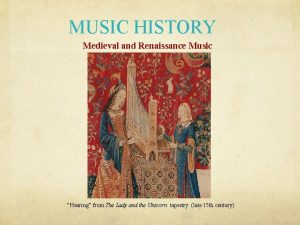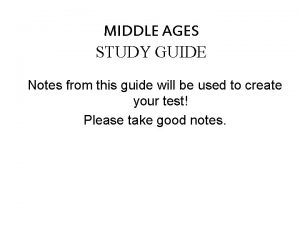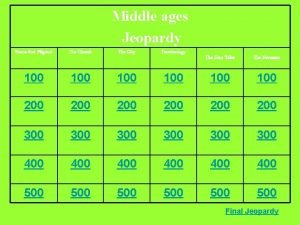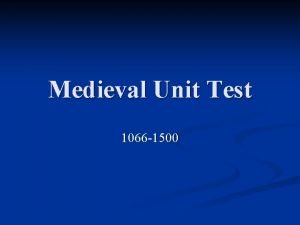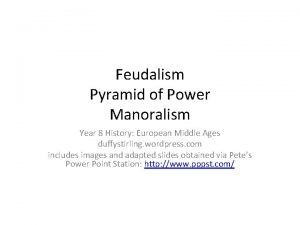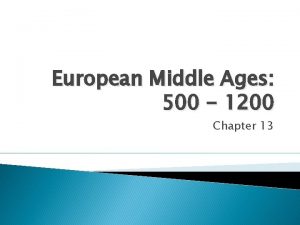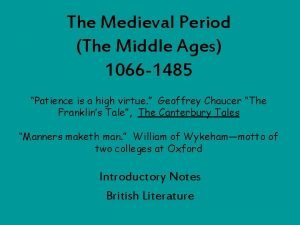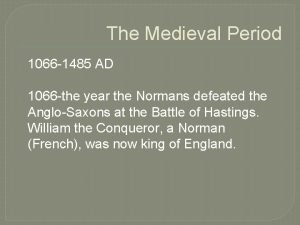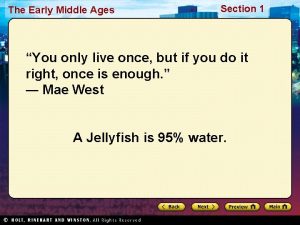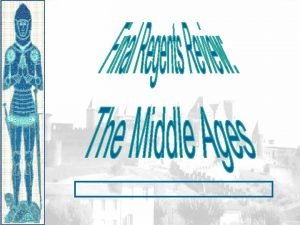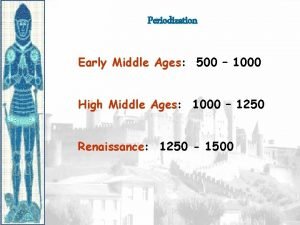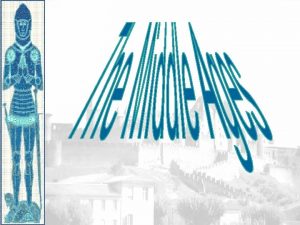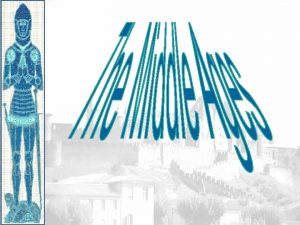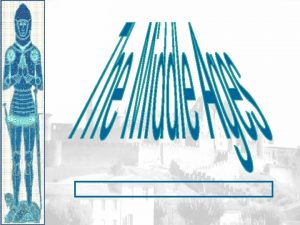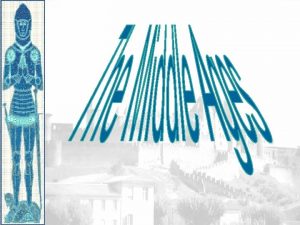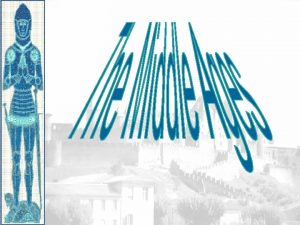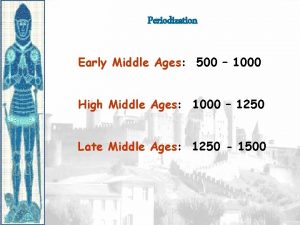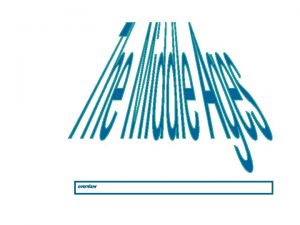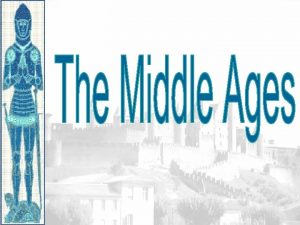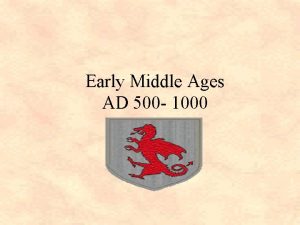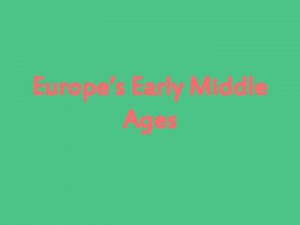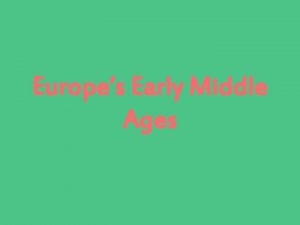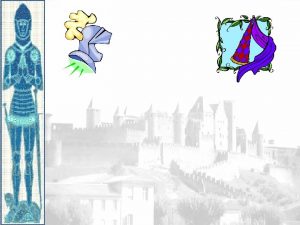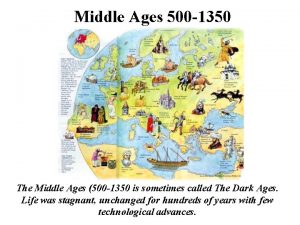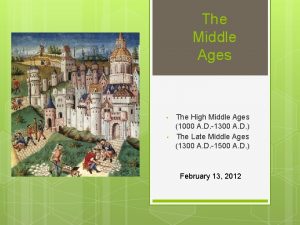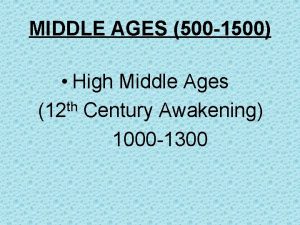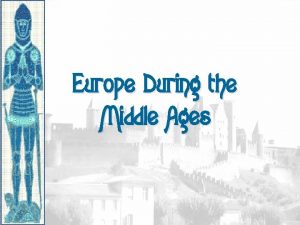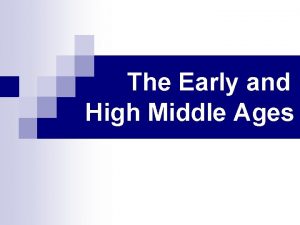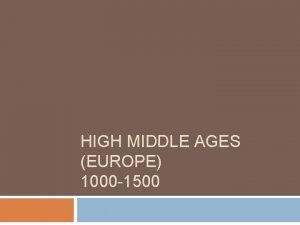Periodization Early Middle Ages 500 1000 High Middle















































- Slides: 47


Periodization Early Middle Ages: 500 – 1000 High Middle Ages: 1000 – 1250 Late Middle Ages: 1250 - 1500

Europe in the 6 c

The Age of Charlemagne e. The New Germanic Kingdoms e 500 W. Roman Empire had been replaced by German Kings. e. Ostrogoths in Italy and Visgoths in Spain retained the Roman structure of government e. Angles and Saxons (Germanic tribes from Denmark & N. Germany) Anglo-Saxons e. The Kingdom of the Franks e. Established by Clovis – Conquers Gaul e converted to Christianity. e. Wergild – “money for a man”; a fine paid by a wrongdoer to the family of the victim. e. Ordeal – determining guilt in Germanic Law

The Age of Charlemagne e Charles Martel e. Muslim expansion into the Iberian Peninsula e. Battle of Tours 732 C. E. e. The Carolingian Empire e. Charles the Great – Charlemagne r. 768 – 814 e. Expanded the Frankish kingdom e. Covered much of western & central Europe e. Missi dominici- messengers who ensured the counts were loyal to the king.

Pope Crowned Charlemagne Holy Roman Emperor: Dec. 25, 800

Charlemagne: 742 to 814 e. Charlemagne as Roman Emperor e“Emperor of the Romans” (Roman, Christian, & German elements united) e 1 st Holy Roman Emperor

Charlemagne’s Empire

Romanesque Architectural Style e. Carolingian Renaissance e. Promoted learning – monks rewrote the classics of Greece & Rome e. Rounded Arches. e Barrel vaults. e Thick walls. e Darker, simplistic interiors. e Small windows, usually at the top of the wall.

The Carolingian Renaissance

Carolingian Miniscule

Charlemagne’s Empire Collapses: Treaty of Verdun, 843

Invasions of Europe, 700 - 1000

Feudalism I. The End of the Carolingian Empire I. Divisions & Invasions in the Carolingian Empire I. Charlemagne dies in 814 – within 30 years his empire is divided. II. Norsemen/Northman from Scandinavia ( Vikings) invade. I. Long narrow ships – good for river access. II. Normandy – 911 Seine River in France – Normandy III. Franks settled Vikings & Converted the to Christianity

II. Emerging Feudalism I. Feudalism - political and social order that developed during the Middle Ages when royal governments were no longer able to defend their subjects; nobles offered protection and land in return for service Knights & Vassals II. I. III. Fief – a grant of land made to a vassal Vassal – served lord in military capacity Knight – heavily armored cavalry The Feudal Contract – the written rules that determined the relationship between a lord and his vassal.

Feudalism A political, economic, and social system based on loyalty and military service.

The Medieval Manor

Life on the Medieval Manor Serfs at work

Parts of a Medieval Castle

Carcassonne: A Medieval Castle

III. The Nobility of the Middle Ages I. Nobles- Kings, dukes, counts, barons, or bishops II. Chivalry – the ideal of civilized behavior that developed among the nobility; it was a code of ethics that knights were supposed to uphold III. Aristocratic Women I. II. Could manage the estate – When the lord was away Overseeing food supply and maintain needs for the household. III. Subservient to their husbands IV. Eleanor of Aquitaine – influential woman of the time

The Road to Knighthood KNIGHT SQUIRE PAGE

Chivalry: A Code of Honor and Behavior

The Medieval Catholic Church v filled the power vacuum left from the collapse of the classical world. v monasticism: § St. Benedict – Benedictine Rule of poverty, chastity, and obedience. § provided schools for the children of the upper class. § inns, hospitals, refuge in times of war. § libraries & scriptoria to copy books and illuminate manuscripts. § monks missionaries to the barbarians. [St. Patrick, St. Boniface]

A Medieval Monk’s Day

The Power of the Medieval Church v bishops and abbots played a large part in the feudal system. v the church controlled about 1/3 of the land in Western Europe. v tried to curb feudal warfare only 40 days a year for combat. v curb heresies crusades; Inquisition v tithe 1/10 tax on your assets given to the church. v Peter’s Pence 1 penny person [paid by the peasants].

A Medieval Monastery: The Scriptorium

Illuminated Manuscripts

Changes in Agriculture • Farming Technology – Iron plow – Horse collar • Food Output & Population – Three field system • Wheat • Legumes – peas & beans • Fallow

Trade and finance Expands Merchants traveled hauling items to towns on fair days to trade. - Fairs met the needs of people, no longer was self-sufficient. Hanseatic League – association of towns in N. Germany that banded together to protect trade interests.

Medieval Guilds: A Goldsmith’s Shop Guilds: Associations of people with the same trade (job/skill) -Controlled wages and prices -Provided technical training -Organized social welfare for members. Only masters of a trade could become a guild member.

Crest of a Cooper’s Guild

Medieval Guilds Guild Hall v Commercial Monopoly: § Controlled membership apprentice journeyman master craftsman § Controlled quality of the product [masterpiece]. § Controlled prices

Steps to Become a Master • A child became an apprentice for 5 -9 years with out pay. • After a period of training a boy became a Journeyman and could work for low wages • Final step: a Journeyman made an item that was considered a master piece of work • If the product met guild standards, he was welcomed into the guild and could open his own shop.

Late Medieval Town Dwellings


Medieval Trade

Revival of Towns and Learning • People, especially serfs, began leaving the Feudal Manors in search of economic and social opportunities • Towns developed at random along trade routes, very dirty crowded areas - Burgesses: Common people, living in the towns. • As towns grew, so did the desire to learn.

Learning in Europe • Universities developed • Scholars translated books into everyday vernacular (language) instead of Latin. • Revival of learning sparked European interest in the works of ancient scholars. - Crusade brought Europeans into contact with Muslims who had preserved the writings.

Oxford University

Medieval Universities

Gothic Architectural Style e Pointed arches. e High, narrow vaults. e Thinner walls. e Flying buttresses. e Elaborate, ornate, airier interiors. e Stained-glass windows. “Flying” Buttresses

Setting Out on Crusade • Byzantine Emperor asks Pope (Urban II) for help against Turks/ Fatimid • Series of Wars. Crusades • (4) 10961204 c. e.

Pope Urban II: Preaching a Crusade Council of Clermont 1095

• Negative: mistrust b/w Muslim world & Christian world • Positives: trade flourished b/w east and west learning from Muslim scholars spread to Europe

Christian Crusades: East and West

Effects of the Crusades • Growing Demand for Goods – – – What type of goods were introduced to Europe? What was the role of Italian Merchants How did a money economy change medieval life? • Monarchs & the Church – How did the Crusades affect the roles and relationships of Monarchs & Church? • Europeans gained wider view of the World – How did contact with Muslims influence Europeans’ world view?
 Dark ages def
Dark ages def Renaissance art vs medieval art
Renaissance art vs medieval art Early middle ages
Early middle ages Early middle ages
Early middle ages Tactical periodization youth soccer
Tactical periodization youth soccer Isokinetic exercise
Isokinetic exercise Matveyev's model of periodization
Matveyev's model of periodization The high and late middle ages section 5 quiz
The high and late middle ages section 5 quiz High to late middle ages
High to late middle ages High middle ages
High middle ages Chapter 7 early childhood ages 3 through 5
Chapter 7 early childhood ages 3 through 5 The stone ages and early cultures
The stone ages and early cultures 100 200 300 400 500 600 700 800 900 1000
100 200 300 400 500 600 700 800 900 1000 3500-500
3500-500 European middle ages map
European middle ages map Middle ages renaissance
Middle ages renaissance Germanic kingdoms in the middle ages
Germanic kingdoms in the middle ages French period flowers
French period flowers Medieval mosaic art
Medieval mosaic art Late middle ages timeline
Late middle ages timeline Gregorian chant composers
Gregorian chant composers Dark ages vs renaissance
Dark ages vs renaissance Middle ages def
Middle ages def Middle ages description
Middle ages description Astronomy in medieval times
Astronomy in medieval times Catholic church ranks
Catholic church ranks Middle ages jeopardy
Middle ages jeopardy What were two indirect results of the crusades
What were two indirect results of the crusades Feudal system in the middle ages
Feudal system in the middle ages Cathedral art
Cathedral art What does the word rebirth mean
What does the word rebirth mean Similarities between middle ages and renaissance
Similarities between middle ages and renaissance Middle ages def
Middle ages def Lesson 4 the late middle ages
Lesson 4 the late middle ages Art of emerging europe middle ages
Art of emerging europe middle ages Middle ages
Middle ages The middle ages spans nearly one thousand years.
The middle ages spans nearly one thousand years. Middle ages study guide
Middle ages study guide Language answer
Language answer The middle ages 1066 to 1485 unit test
The middle ages 1066 to 1485 unit test Early american floral design
Early american floral design Feudal pyrimid
Feudal pyrimid The great schism
The great schism The middle ages outcome the power of the church
The middle ages outcome the power of the church Medieval time
Medieval time The middle ages 1066 to 1485: unit test
The middle ages 1066 to 1485: unit test Middle ages nobles
Middle ages nobles Sacred music in the middle ages
Sacred music in the middle ages


